Around the turn of this century, when Tiger Woods could win nine tournaments a year and America opened a new golf course every day, if you were planning a bucket-list Irish golf trip for the summer, you had better have gotten started by New Year's Day.
Such were the crowds, the rush for cheap air fares and the availability of quality hotel rooms in parts of rural Ireland, where you went to find mysterious magisterial links such as Ballybunion, Lahinch and Rosses Point.
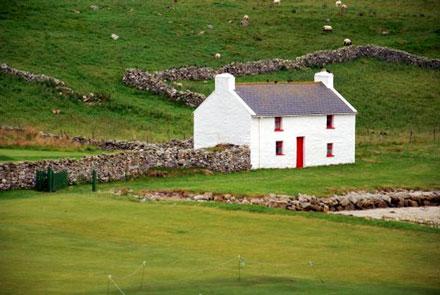
But more than 800 courses have closed in the past decade in the U.S., many European golf resorts hit the rocks and the curious millennials who once made Tiger's galleries look like a Beatles tour are doing CrossFit somewhere. Golf has returned to normal. And yes, there's been some terrorism in Europe.
All of which means making this Ireland trip work on relatively short notice is now easier and often more affordable than in years past, and the courses -- radiant natural landscapes set among the highest coastal sand dunes in golf architecture -- are less crowded.
After some 80 rounds of golf in Ireland since 2000, I've gathered a few tips for making the trip go well. I do have a bias. I shy away from the grand Medieval Castle-cum-golf-extravaganza you'll find here and in Scotland, mainly due to the cost and corporate pomp, but they are easily found and enjoyed by the busloads.
The good news is that May-to-September airfares to Ireland – once difficult to find under $1,200 roundtrip – have improved, and with the now-cheaper Euro at about $1.12, your golf pilgrimage doesn't need to be any more expensive than a domestic trip to, say, Maine.
When should I go?
From May, the sunniest month, until about mid-October is grand. July and August get a dash more rain, but they also get about 18 hours of daylight, so those inclined can easily play 36 holes a day. September is perfect. It's somewhat drier, the students aren't under foot and you might find some deals. The east coast is generally drier than the west, with the Dublin Airport weather station reporting some 128 wet days to 193 out west in Belmullet, home to gorgeous Carne Golf Club.
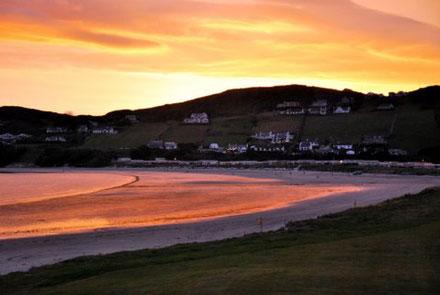
What should a golfer wear?
Unless an Irish fisherman gives me a certified forecast of clear sky all day, I'm going out with these basic three layers either on me or packed inside my golf bag: a long-sleeve, snug, thermal top next to my skin; a light sweater, sweatshirt or thick, collared golf shirt (a few stodgy courses still require collars), and then the absolutely indispensable, totally waterproof, golf jacket. Variations like sweater-vests will free up your arms a bit. Just smile at the Irish golfers in short sleeves when it's 52 with 25 m.p.h. wind. If it's not raining, they're thrilled.
You will need waterproof pants. Some golf-trip veterans start the day with them and never take them off, rather than do frantic mid-fairway disrobing during Ireland's quick-and-furious ocean squalls. I usually just pack them in the golf bag. But be sure you've checked all the zippers and snaps before your first dose of sideways icepick rain.
On the worst days, I'm thrilled I brought items like Smartwool's Merino baselayer long underwear, which also takes up very little bag space.
Wear warm moisture-wicking socks and waterproof golf shoes. I've been wearing Ecco for about eight years and think their new Cool 18 GTX, with GORE-TEX lining and a ventilated sole, might be the best waterproof shoe on the market. But seriously, hose down your shoes weeks before you go and make sure the inner lining stays dry. Otherwise you're miserable.
Bring gallon-size plastic baggies and keep dry your spare socks, and stuff like cameras, yardage books and wallet. (Or use waterproof golf bags like Sun Mountain's, which I've carried about 10 years. Colorful, good straps, under 4 pounds and moisture tight.)
Bring a ski cap, waterproof rain hat or both.
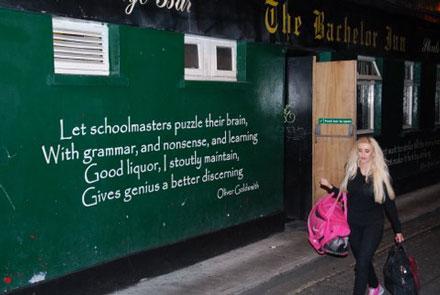
I've occasionally brought gloves for warmth, but not for full-time golf use. That's a personal thing for golfers. Those small hand-warmer packets -- about $4 at Golf Galaxy -- are a great idea. Keep hands, head and feet warm, and you'll make it through any four-season, Irish summer day.
But you may catch an entire week of high 60s with hardly a cloud above. You'll feel silly and overdressed until the day you're not. Just prepare for 50 to 70 degrees, with stout wind and frequent rain that can turn a normal day into a Viking seal hunt.
Should I rent a car, hire a driver or do one of those golf bus tours?
First, know thyself.
Do you love to spend hours talking with newly met friends and explore the nearby town on foot? You might need the independence of a rental car.
If you've never driven on the left, it is an adventure and I haven't a clue how a Yank can prepare. On my first try, I decided to fly into Shannon, rather than Dublin, so I wouldn't have to deal immediately with a congested ancient city. But I didn't plan on a badly delayed flight, so I got my first driving-on-the-left lesson at midnight.
I would strongly suggest using an automatic if you've never negotiated a roundabout shifting left-handed.
When bargains aren't paramount, hiring a driver for a mini-bus tour of 4 to 8 members seems smart. Ireland has amazing bus drivers – funny, thoughtful, professional, and often good golfers – and this strategy allows you to tailor your trip exactly to your group's needs, especially if you have non-golfers.
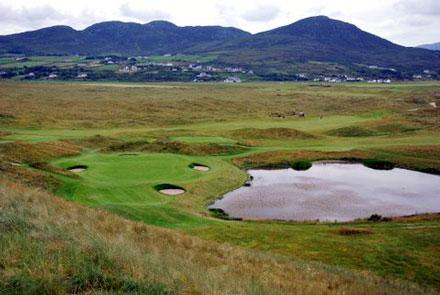
The advantages to hiring a driver are many: You never worry about directions and hassles, nor being drunk behind the wheel. You just play golf. However, renting a car allows you to see far more of the country at your own pace and dispense with group-think etiquette.
There are a number of excellent golf tour operators with whom you'll have a wonderful experience. The two I know best are Irish Links Tours & Travel, based in Connecticut, and North & West Coast Links, out of Galway, Ireland. Both work closely with all the great courses, but can set up any kind of tour you wish anywhere on the island. They are ethical, flexible and knowledgeable. The tour options are too numerous to mention, but week-long packages can be had for roughly $1,800 to $2,500 per golfer, not including airfare.
We're starving artists. How do you do this completely on the cheap?
Book the airfare months ahead of time, and try airlines like Norwegian, which offers low fares from cities such as Boston, New York, Los Angeles and much of Florida, among others. (In mid-June, I found a Boston-Dublin non-refundable roundtrip in late August for about $800 on Norwegian, including checked bags, reserved seats, food and, since it's Scandinavian, civility. Be wary of American Airlines and its notorious customer service.)
Rent a car or share a van. Stay in small inns and B&B's, where you'll make more friends, including members of local golf clubs who can get you on as guests. In many small towns, such as Ballybunion and Lahinch, you'll be able to walk to the golf course from your home.
Regional discount golf cards are abundant in Ireland. Just know where you want to go, then consult online Irish golf sites like Golf Ireland, run by Irish Tourism, or seek out Irish golf magazines. Most of all, bargain with the clubs. After researching their green fees, contact the course's general manager and say you're a Yank foursome looking for a deal. Don't be shy.
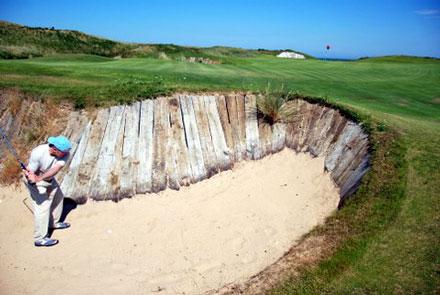
Where should we play?
Ireland has four primary golf regions. To know them better, find what still ranks as the best Irish golf guide, "Links of Heaven," by Richard Phinney and Scott Whitley. Here's my take:
Dublin and the East: The capital city has outstanding golf. Try County Louth (Baltray), The Island, Portmarnock Golf Club (founded 1894), its young neighbor Portmarnock Golf Links and a bit south, a world top 100 fixture, The European Club, designed by the inimitable Pat Ruddy.
Northern Ireland: Remember, a separate country, part of the United Kingdom, stiff upper lip, British pounds, not Euros. Here you get world top-tens, Royal Portrush and Royal County Down, both open to the public (take that, Augusta!), plus Portstewart, Ballycastle, Castlerock and Ardglass. In lively Belfast, two parkland courses, Belvoir Park and Malone, are stunning and fun.
The Northwest: A wonderful vacation could be made of just Carne, Enniscrone and County Sligo (Rosses Point), but you also get Ballyliffin, Rosapenna, Portsalon, Donegal, Narin & Portnoo, Connemara and my new favorite parkland course, Westport. Great salmon fishing on the Moy. Fabulous golf at about one-third of what you'll pay in the more-touristed Southwest.
The Southwest: This where the Irish Golf Miracle began, with Tom Watson singing the praises of Ballybunion after a visit in 1981. You'll also love Waterville, Dooks, Tralee, Ceann Sibeal (Dingle) and glorious Lahinch. It's all great, but Ballybunion and Lahinch are steep at $200. Bargains can be had.
What are some veteran tips to make the trip memorable?
Don't always play and socialize as The Inseparable American Foursome. You'll rarely make real Irish friendships this way. Break things up. Ask specifically to play with club members and sometimes they'll oblige.
Don't shout in the parking lot like you own the place. Always take off your hats in the clubhouse. The garrulous Yank tour bus group arguing about some forgotten Super Bowl has earned a bit of a reputation.

Use pull carts. They do. You won't see many motorized carts. If you spend 51 weeks of the year riding a cart to play golf, you need to start training for walking the dunes of Ireland.
Among your golf ball arsenal bring some you can afford to lose.
Ireland has great music. Do your research on the clubs and who might be playing during your visit. With just a little planning, your miserable golf score can be forgotten with a fire-breathing, neo-Celtic funk band at a totally smoke-free Irish pub.
All national museums and galleries are free.
Eat more fish and seafood chowder. Ireland cannot outdo us on steaks or hamburgers, but their North Atlantic seafood is special. Try the wild arctic char.
Get over your score. Ireland will be some of the toughest golf you will ever play, even without rain and wind. Quirky architecture, waist-high blonde grasses and the constant wind may wreak havoc with a dainty American handicap.
Focus on friendships and having fun. Take your photos near dawn and sunset on the dunes. Exchange business cards, write thank-you notes and bring something uniquely American for that special caddie or bus driver.
-- Bruce Selcraig is a former staff writer with Sports Illustrated whose work has appeared in The New York Times Magazine, Harper's and The Atlantic, among others. Contact him at selcraig@swbell.net.





